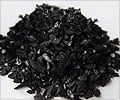Hyperglass, a new material containing hollow glass balls, deflects 85 per cent of the heat that hits it. The white coating can thus bring down air-conditioning costs and also cut down on carbon emission.
The cool roofs are being touted as a simple, inexpensive way of lowering surface temperatures on the tops of structures by as much as 100 degrees, cutting operating costs and slowing climate change.Designed by an 82-year-old former military scientist from the Inland Empire, the tinted topcoat is filled with tiny hollow glass balls that deflect heat, layered over a waterproof undercoat made of recycled rubber.
Ronald R. Savin of Rancho Mirage is a serial inventor and holder of nearly 20 patents. His Hyperglass top coat is designed like a Rice Krispies treat. Glass "microspheres," which are used to lighten airplane parts and bowling balls, are suspended in a paint that includes Teflon. The whiter the titanium dioxide tint, the more heat bounces off.
Underneath, his Hyperflex primer serves as an insulation layer that also helps prevent water damage and erosion. And because it uses powdered recycled rubber, it helps address another thorny environmental issue: the millions of tires discarded annually in the U.S.
The paint could spawn "such a violent change in the paint industry that they won't know what to do," Savin said.
Hyperseal paints are free of harmful volatile organic compounds known as VOCs and are relatively cheap to produce, but the company's Palm Desert factory can make only 5 million gallons a year. Most large projects, such as bridges, require several hundred million gallons, Savin said. So he's looking to license his formula to other companies.
Energy Secretary Steven Chu, a Nobel Prize winner in physics, recently called for all roofs to be painted white to promote saving energy.
Advertisement
In his lecture, Prof.Chu claimed that by lightening all paved surfaces and roofs to the colour of cement, it would be possible to reduce carbon emissions drastically – it would be like all the world’s cars off the roads for 11 years.
Advertisement
But skeptics say white roofs aren't always the eco-friendly panacea they're sometimes made out to be. The reflective component is most effective in sun-saturated regions like the Southwest. And it could lead to higher heating bills in the winter because the sun's warmth can't permeate the roof, Tiffany Hsu writes in Los Angeles Times.
Still, the niche is booming. At the moment a Hilton unit is experimenting with the hyperseal. If it really brings down the energy significantly, the enter chain might go for it.
The Energy Department and U.S. Green Building Council are pushing cool roofs to consumers and developers. Entrepreneurs are developing a host of new products using metal, ceramic tile, reflective paints and coatings and even rooftop gardens to beat the heat.
Big players including Sherwin-Williams Co. and Benjamin Moore & Co. are also debuting eco-friendly paints. The field is getting exciting indeed.
Source-Medindia
GPL










